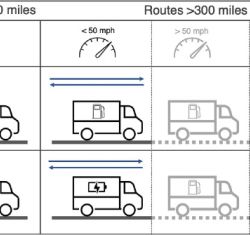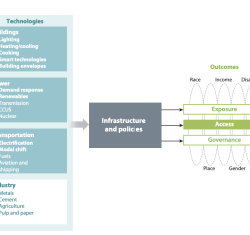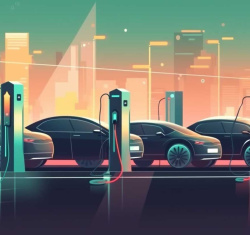
 back to all faculty
back to all faculty
Parth Vaishnav

About
My research aims to understand how technology can help solve social problems. Much of my work focuses on the environmental and human health consequences of energy production and use. I employ quantitative decision analysis, buttressed by qualitative insight, to understand how economic, political, and operational realities constrain technology deployment.
I focus on finding strategies to decarbonize the economy, and to adapt to the warming that has and will occur even if we cut greenhouse gas emissions very rapidly. I am particularly interested in finding ways to make both mitigation and adaptation equitable. My projects fall into two broad categories:
- The environmental consequences of electrification, and
- The consequences of automation for the environment, equity, and work
Publications
JOURNAL PUBLICATIONS
Note: At Carnegie Mellon University, it was standard practice to co-author with students and for students to
assume first authorship. Collaboration is strongly encouraged. “+” indicates a Ph.D. student.
- Shen, X., Liu, P., Qiu, L., Patwardhan, A., Vaishnav, P., 2020. “Estimation of change in house sales prices in the United States after heat pump adoption” Nature Energy, https://doi.org/10.1038/s41560-020-00706-4
- Vaishnav, P., Fatimah, A.M., “The environmental consequences of electrifying space heating with current and future energy mixes” Environmental Science & Technology, 54(16), pp.9814-9823.
- Mohan, A.,+ Sripad, S., Vaishnav, P., Viswanathan, V., 2020. “Trade-offs between automation and light vehicle electrification” Nature Energy 5, 543–549
• Notable paper: This paper explores the question of whether it is possible, in the medium term, to make light vehicles both autonomous and electric. It uses first-principles energy modeling to conclude that the energy penalty associated with automation will likely not exceed 15% of the range of electric vehicles currently on the market. It then advances a series of economic arguments that use customers’ revealed preferences to suggest that travelers will value autonomy more than they do this loss of range. The paper won the Herb Toor Award at EPP for Best Qualifier paper for my doctoral student Aniruddh Mohan. - Reed, L., + Dworkin, M., Vaishnav, P., Morgan, M.G., 2020. “Expanding Transmission Capacity: Examples of Regulatory Paths for Five Alternative Strategies,” The Electricity Journal, 33(6), p.106770.
- Funk, P.,+ Davis, A., Vaishnav, P., Dewitt, B., Fuchs, E.R.H., 2020. “Individual inconsistency and aggregate rationality: Overcoming inconsistencies in expert judgment at the technical frontier,” Forthcoming at Technological Forecasting and Social Change
• Ian Wright, Managing Editor of www.engineering.com produced an eBook entitled, “Should You Use Additive Manufacturing to Produce Your Next Part?” which draws on this research and cites it. Available here: https://www.engineering.com/ResourceMain.aspx?resid=779 - Reed, L.,+ Morgan, M.G., Vaishnav, P., Armanios, D.E., 2019. “Converting existing transmission corridors to HVDC is an overlooked option for increasing transmission capacity.” PNAS 116, 13879–13884. https://doi.org/10.1073/pnas.1905656116
- Bonnín Roca, J., Vaishnav, P., Laureijs, R.E., Mendonça, J., Fuchs, E.R.H., 2019. Technology cost drivers for a potential transition to decentralized manufacturing. Additive Manufacturing 28, 136–151. https://doi.org/10.1016/j.addma.2019.04.010
• Notable paper: This paper shows that the economics of distributed metal additive manufacturing (AM) are preferable to centralized additive manufacturing in only a limited set of circumstances. In some cases, political support for AM is based partially on the assumption that the technology will foster the localization of manufacturing. Some analysts speculate that AM will reduce the need for freight and contribute to reducing greenhouse gas emissions. This paper suggests that such expectations are overblown. - Abdulla, A., Vaishnav, P., Sergi, B.,+ Victor, D.G., 2019. “Limits to deployment of nuclear power for decarbonization: Insights from public opinion.” Energy Policy 129, 1339–1346. https://doi.org/10.1016/j.enpol.2019.03.039
• Notable paper: This paper demonstrates an approach to help analysts to estimate the extent to which public fear of a technology might constrain its development. For controversial technologies like nuclear power, modelers typically evaluate two extreme but unrealistic scenarios: one, where the technology is deployed to the extent that is economically optimal, and two, where the controversial technology is completely excluded. We show that it is possible for modelers to improve on this approach by estimating the extent to which a public will allow the deployment of a technology, given the public’s anxieties about it. - Hanus, N.L.,+ Wong-Parodi, G., Darghouth, N.R., Vaishnav, P., Azevedo, I.L., 2019. “Solar PV as a mitigation strategy for the U.S. education sector,” Environmental Research Letters 14, 044004. https://doi.org/10.1088/1748-9326/aafbcf
Ph.D. Engineering and Public Policy, Carnegie Mellon University, 2015
M.Phil. Technology Policy, University of Cambridge, United Kingdom, 2011
Master of Technological Design, National University of Singapore and Eindhoven University of Technology, Netherlands, 200
Bachelor of Engineering (Mechanical), Minor in Bioengineering, National University of Singapore, 2003









